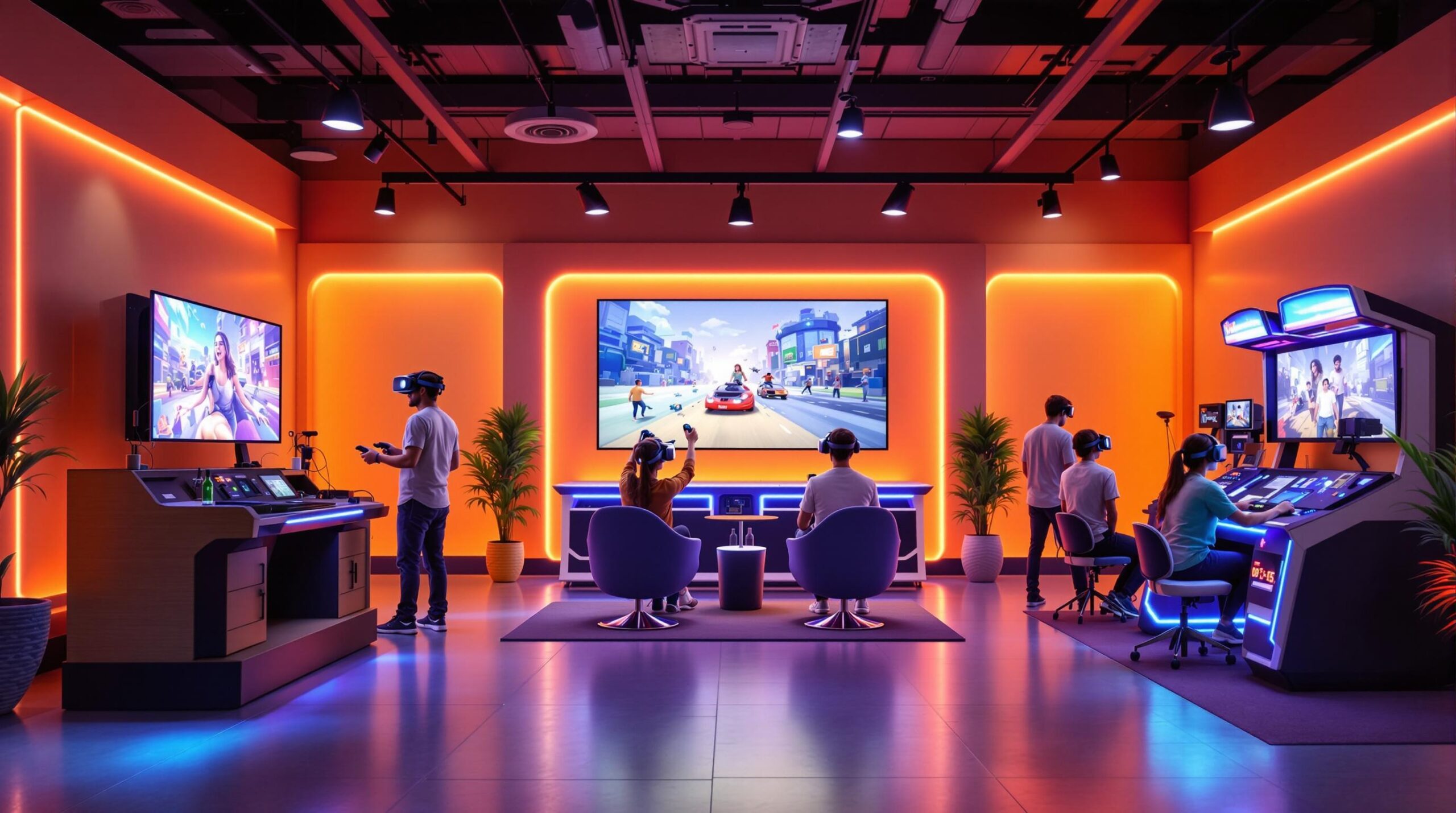
Want to start a VR arcade? Here’s what you need to know: Picking the right VR system is crucial for your success. It impacts costs, customer satisfaction, and your ability to scale as the VR industry grows by over 30% annually. Here’s a quick breakdown to help you decide:
Quick Comparison Table:
| Feature | HTC Vive Enterprise | Meta Quest 3 | Varjo VR-3 |
|---|---|---|---|
| Price | $1,200 | $499 (128GB) | Contact sales |
| Tracking System | Base stations | Inside-out | Inside-out + eye tracking |
| Setup Complexity | High | Low | Medium |
| Commercial License | Included | Separate purchase | Included |
Start with systems that fit your budget and audience, and plan for growth with scalable setups and proper licensing.
Gaming appeals to a broad audience, spanning different ages, genders, and income levels.
Here are some key stats about gamers:
When choosing a VR system, think about who your main customers are. For casual gamers, go for systems that are easy to use and support shorter play sessions. On the other hand, hardcore gamers may prefer high-performance systems with advanced features and competitive multiplayer options.
Your arcade needs enough room not just for gaming stations but also for waiting areas and staff workspaces. Here’s what to keep in mind:
Different VR systems have unique space needs. For example, the HTC Vive often requires more room for its room-scale experiences, while systems like PlayStation VR can work in smaller setups.
Your budget will shape what VR systems you can afford for your arcade. Here’s a quick cost breakdown:
| Expense Category | Typical Cost Range |
|---|---|
| VR Equipment (5–10 systems) | $2,000 – $15,000 |
| Gaming PCs/Consoles (per unit) | $1,500 – $3,000 |
| Software Licensing | $5,000 – $20,000 |
| Insurance (Annual) | $1,500 – $3,000 |
| IT Setup | $5,000 – $15,000 |
To save money, consider starting with mid-range systems, which can cut equipment costs by 30–40%. You can also add more stations over time and keep 10% of your budget aside for unexpected costs.
The total initial investment for a VR arcade usually falls between $50,000 and $250,000. Focus on finding the right balance between cost and quality that fits your market and customer needs. Defining these requirements upfront will make it easier to compare VR system options.
Once you’ve outlined your arcade’s needs, the next step is to evaluate the features of different VR systems.
The tracking technology used by a VR system can significantly impact its performance in an arcade setting.
Now, let’s look at how display performance can shape the user experience.
The quality of the display plays a huge role in how users perceive and enjoy VR. Here’s a comparison of popular systems:
| VR System | Resolution | Refresh Rate | Field of View |
|---|---|---|---|
| Varjo VR-3 | 2,880 × 2,720 | 90 Hz | 115° |
| PIMAX 8K | 3,840 × 2,160 | 120 Hz | 200° |
| Valve Index | 1,440 × 1,600 | 144 Hz | 130° |
Studies suggest that a refresh rate of 120 fps can help reduce VR sickness.
The type of connection – wired or wireless – can influence both gameplay and operational flexibility.
The success of your arcade depends heavily on offering games that engage your audience. With VR reaching 171 million users worldwide, there’s a huge opportunity for arcades to tap into this growing market.
When choosing games, you’ll generally decide between two main types:
| Type | Characteristics | Best For |
|---|---|---|
| Attended VR | – Group-oriented play – Requires more space – Easier to guide players – Higher staffing needs |
High-traffic locations with dedicated staff |
| Unattended VR | – Lower equipment costs – Higher revenue per square foot – Self-service setup – Simpler gameplay |
Locations with limited staff |
For instance, Pole Position Raceway in Las Vegas saw a 53% increase in park-wide revenue after introducing the Virtuix Omni Arena. Even more impressive, 40% of visitors came specifically to experience it.
Once you’ve chosen your games, it’s essential to establish a licensing strategy that keeps costs under control while giving you access to the right content.
Licensing is a key factor in managing VR content costs. Here are the main options:
Monthly Subscription Plans
Platforms like VR Arena Games offer subscription tiers:
These plans typically include access to five VR free-roam games.
Pay-Per-Minute Model
Some developers now offer a pay-per-minute pricing structure, often around $0.10 per minute per player.
"Moving to per-minute is going to be a major boom for the business."
Tips for Managing Costs:
If you’re using free games, ensure you have the proper licenses to protect your business and support developers.
Platforms like SpringboardVR, which serves over 250 companies in 96+ countries, can simplify licensing, installation, and usage tracking. They also offer extensive game libraries, making content management easier.
To ensure smooth VR gaming performance at 72–144 FPS, you’ll need a powerful computer setup.
Here’s a breakdown of the minimum and recommended specs for commercial VR systems:
| Component | Minimum Requirement | Recommended for Arcade Use |
|---|---|---|
| Processor | Intel i5-4590 / AMD Ryzen 5 1500X | Intel i7 / AMD Ryzen 7 or better |
| Memory | 8GB RAM | 16GB RAM |
| Graphics Card | NVIDIA GTX 970 / AMD R9 290 | Higher performance models |
| Operating System | Windows 10 | Windows 10/11 |
Key Technical Notes:
Regular maintenance is essential to keep your systems running smoothly and avoid interruptions.
Even top-tier hardware needs consistent upkeep to maintain peak VR performance. Routine maintenance reduces downtime and helps protect your revenue. For instance, VRKade in Calgary keeps 4 backup headsets for every 10 in use, ensuring a swift replacement process. In their 31-headset operation, 6–8 units are typically under warranty at any time.
Daily Maintenance Checklist:
Security Tips:
"You’ve got to consider theft, you have got to consider those things walking away", says Ben Davenport, CEO of VRsenal.
Support Services:
Stick to a schedule of daily checks, weekly deep cleaning, and monthly evaluations to minimize downtime. Keeping detailed logs can help you identify and address potential issues early.
Thriving VR arcades carefully match their systems to their operational goals. Here are a few standout examples:
"For every 10 headsets one of their stores has, they keep 4 extra on the shelf to replace broken headsets out on warranty."
– Jason Van Hierden, Owner of VRKade
These examples highlight how aligning technology with operational needs can lead to success. However, avoiding common mistakes is just as important.
While success stories provide inspiration, steering clear of common errors is crucial for long-term success.
Equipment Selection Issues
| Common Mistake | Solution | Impact |
|---|---|---|
| Using consumer-grade systems | Invest in enterprise editions | Better warranty coverage and support |
| Poor mounting solutions | Follow proven installation practices | Reduces tracking errors and disruptions |
Strategic Planning Issues
"Moving to per-minute is going to be a major boom for the business."
– James Pollock, CEO/Owner of Arctic Sun VR
Successful arcades like Zero Latency demonstrate the value of offering diverse experiences, such as single-player stations and driving simulators, while maintaining low staffing requirements. This approach highlights the impact of thoughtful system selection and operational planning.
When choosing a VR system for your arcade, it’s essential to weigh hardware capabilities, costs, and operational requirements. Here’s a breakdown of key VR systems to help you make an informed decision.
| Feature | HTC Vive Enterprise | Meta Quest 3 | Varjo VR-3 |
|---|---|---|---|
| Base Price | $1,200 | $499 (128GB) | Contact sales |
| Tracking System | Base stations (marker-based) | Inside-out (no base stations) | Inside-out + eye tracking |
| Setup Complexity | High (requires base stations) | Low (standalone) | Medium |
| Commercial License | Included | Separate purchase required | Included |
| Warranty Coverage | Enterprise-grade | Standard | Enterprise-grade |
| Game Platform | SteamVR, Viveport | Meta Quest Store | SteamVR, Native |
This chart aligns system features with your arcade’s budget, space, and technical requirements, helping you narrow down the best fit.
The HTC Vive is a popular choice for VR arcades, with SpringboardVR data showing its use in over 1,000 locations across 30 countries.
"When you’re setting up multiple units in your space, make sure that there’s no leakage between the Base Stations because nobody wants customers’ headsets graying out or flying sideways––which often leads to vertigo".
HTC Vive Enterprise
Meta Quest 3
Each system’s benefits impact your arcade’s operations, making it important to align your choice with your venue’s specific needs.
| Accessory | Purpose | Recommended For |
|---|---|---|
| Deluxe Audio Strap | Enhances comfort and durability | HTC Vive |
| Base Station Mounts | Ensures secure tracking setup | HTC Vive |
| Charging Docks | Simplifies battery management | All Systems |
For high-traffic locations, enterprise-grade systems with comprehensive warranties are often worth the investment. On the other hand, smaller venues might find standalone systems like the Meta Quest 3 more practical and cost-effective. The goal is to balance initial costs with long-term operational efficiency.
When choosing a VR system for your arcade, it’s crucial to balance cost, support, and operational requirements. Pay attention to hardware durability, proper content licensing, and operational reliability.
Opt for enterprise-grade systems designed to handle heavy use and reduce downtime. Keep in mind that standard VR game licenses don’t cover commercial arcade use. Platforms like SpringboardVR or Viveport Arcade can simplify operations by offering proper licensing and payment solutions.
Enterprise VR headsets often come with strong warranties and support, ensuring your investment is protected. To keep things running smoothly, consider these strategies:
Make sure your VR setup fits your arcade’s space, budget, and customer preferences to keep your business running smoothly.


